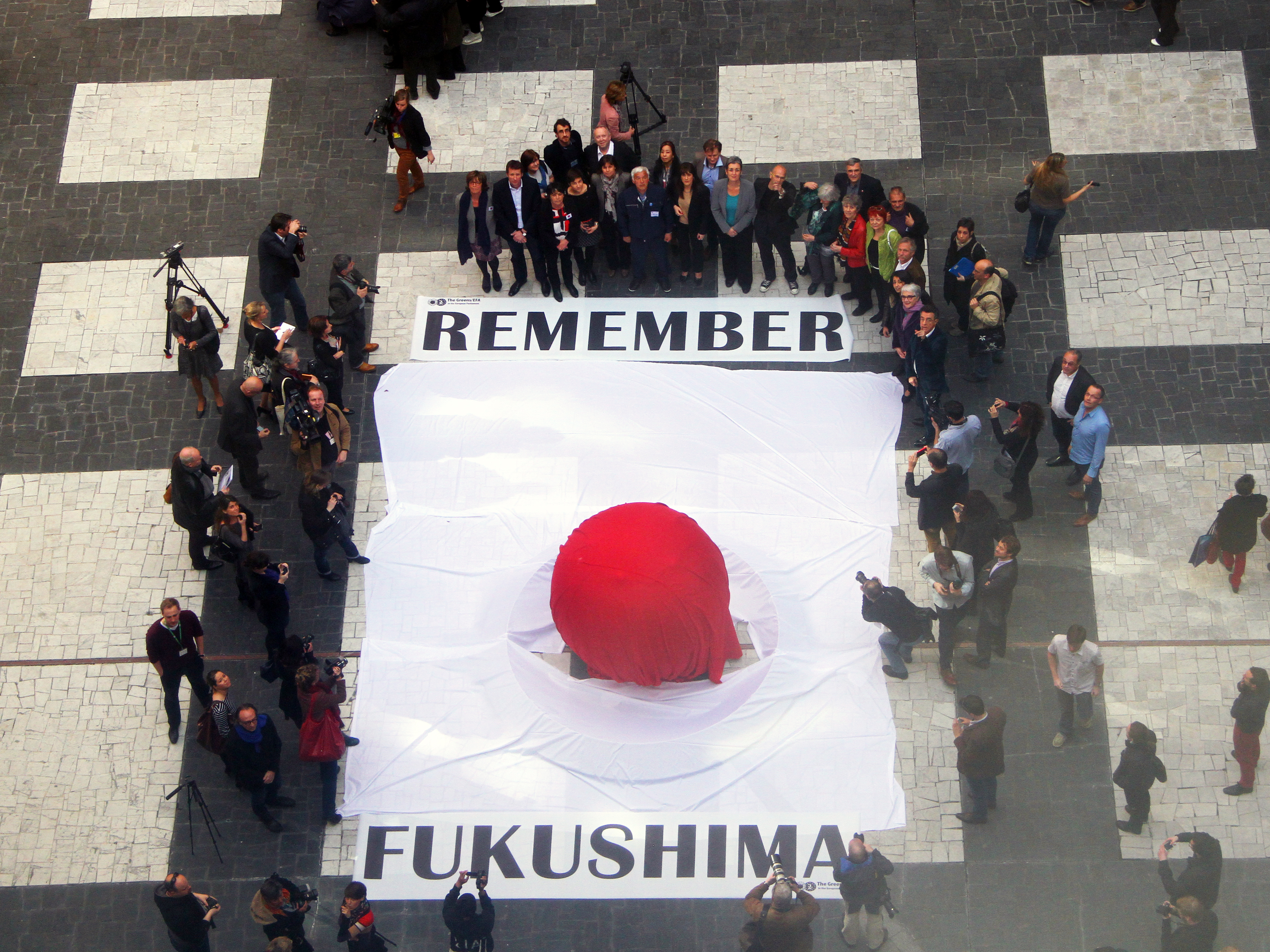By Clément Paule
Translation: Anton Stzepourginski
Passage au crible n°88
 Source : Wikipedia
Source : Wikipedia
At the beginning of April 2013, there were several radioactive leaks near Fukushima where a nuclear catastrophe had happened two years earlier. According to TEPCO (Tokyo Electric Power Company) – private operator in charge of the damaged power plant –, there has been a leak of 120 tons of contaminated water from an underground storage tank. So far, the Japanese company has been estimating that it represents a pollution of almost 710 billions of Bq (Becquerels). Also, at the end of March, the cooling systems that the operator was desperately trying to put back in motion were interrupted because of a power failure. In December 2011, the authorities said the situation had been stabilized with a cold shutdown of the site. Yet all these dysfunctions show how unclear things are when it comes to secure high-risk areas. In January 2013, three reactors of the Fukushima-Daiichi power plant were still releasing radiogenic isotopes – cesium 134 and 137 –, which represented 10 millions Bq/Hr. Therefore, the controversy on sanitarian and environmental consequences of that disaster has not disappeared but it is fueled by ambiguities and paradoxes related to the process of reconstruction.
> Historical background
> Theoretical framework
> Analysis
> References
The triple catastrophe of the 11th March 2011 was classified as Level 7 on the INES (International Nuclear Event Scale) – which is the highest level of seriousness on that scale – and many comparisons were drawn with the Chernobyl disaster (April 1986). The nuclear incident of this power plant situated North of Kiev remains the worst tragedy of all. Radionuclide emissions – especially iodine and cesium 137 – have contaminated more than 100,000 square kilometers and led to the evacuation and relocation of hundreds of thousands. Another example is the nuclear accident at Three-Mile Island that happened in March 1979: 43,000 Curies of radioactive gas were released in the air.
These three failures of civil nuclear power have something in common. Indeed, they all generated ongoing controversies regarding human health impacts. As an example, after the nuclear accident at Three-Mile Island, a scientific team from Columbia University conducted a study in 1990. And according to their results, there wasn’t any significant impact on the epidemiologically situation. However, several other reports showed an increased risk of cancers in Pennsylvania. More recently, in September 2005, the UN (United Nations) report on the impacts of the Chernobyl accident was highly criticized by several associations which accused the IAEA (International Atomic Energy Agency) of minimizing the number of casualties.
1. A poorly managed global pollution. Japanese government and TEPCO operations to resolve this crisis keep on being hindered by many disruptions. That fragile situation is a permanent threat for Japan but also for every GPGs (Global Public Goods) as contamination is now worldwide.
2. An uncertain and controversial record. UN experts tempered the impacts of the Fukushima disaster. Yet the widespread failure of regulations seems to reinforce the absence of confidence against the official speech conveyed by actors who have lost their legitimacy.

Analysis
The disaster that took place on the 11th of March 2011 left a large territory completely traumatized, and there are several main elements to consider when it comes to its reconstruction. Indeed, 160,000 persons have been evacuated from the restricted area and, so far, no solutions have been found regarding their reinstallation and compensation. Also, local populations and authorities were very active whereas the authorities and TEPCO showed a great lack of initiative and are now both completely discredited. Anti- nuclear protests have gained in influence – such as the Sayonara genpatsu petition, “Goodbye to Nuclear Power Plants”, and its 8 million signatures – and several political parties are now militating in favor of these claims. However, the recently elected government seems to have abandoned the idea to phase out nuclear energy by 2030 despite what the outgoing Prime Minister was promoting. Indeed, in June 2012, two nuclear reactors were restarted. Also, the national recovery process was affected by a series of scandals which involved companies and mafia organizations (Yakuza). They were accused of embezzlement and fraud. Moreover, the media reported illegal working conditions and many violations of sanitary norms as reflected by the fate of the Fukushima 50 who were highly exposed to radiation. Japan’s economy suffered a lot from this very expensive catastrophe, especially its agricultural sector and its fishing industry. Also, the country’s lack of nuclear energy had to be compensated by energy imports. Shutting down the power plant is said to cost 100 billions dollars over a forty-year period.
Damaged installations also have to be fixed, if not renewed, and that includes changing the water of the spent fuel pools. However, the main objective is to decontaminate the 2,400-square kilometer area. It represents around 30 million cubic meters of residues – land, branches etc. – that need to be collected and treated. However, the storage of hundreds of thousands of tons of radioactive mud is a huge challenge, especially because of the development of the NIMBY (Not in my backyard) doctrine in many places. Civic associations have opposed to TEPCO’s idea of releasing polluted water into the Pacific Ocean. Even though the company was arguing that it wouldn’t be problematic, that water contained several thousands becquerels per liter. Pollution control devices showed that marine wildlife had been impacted. Many fishes show a level of Cesium above the threshold limit of 100 Bq/kg set by the authorities which rule seafood products. However, several scientists say they may be higher than what TEPCO alleged. In October 2012, a study postulated that there was a constant leak at the power plant since 19 months. That study didn’t rule out a possible contamination in deep ocean waters.
Today, there is a general uncertainty as to low-dose radiations and their consequences over the next generations. In May 2012, the WHO (World Health Organization) confirmed what had already been said by the IRSN (Institute for Radiological Protection and Nuclear Safety), that global radioactive emissions were less severe than expected. According to the WHO, starting the 24th of March 2011, there were traces of radioactive materials – cesium 134 and 137, tellurium 132 – in France, but their levels were 500 to 1000 times below than after the Chernobyl disaster in 1986. These results were later confirmed by the UNSCEAR (United Nations Scientific Committee on the Effects of Atomic Radiation) which final report is expected for October 2013. However, another report of the WHO released in February 2013 was highly criticized by Greenpeace. This environmental NGO say that some data were minimized. Yet, the WHO was also blamed by the Japanese government because of their alleged exaggeration of localize increased of cancer rates. Such conflicting viewpoints fuel the growing suspicion on private and public actors of the nuclear field and, more broadly, on standards that seem to be less and less observed. Therefore, that controversial management once again raises the problem of the forced pooling of a global risk.
Paule Clément, « De l’opacité des responsabilités à la mutualisation forcée du risque. La gestion de l’accident nucléaire par TEPCO à Fukushima-Daiichi, 11 mars 2011 », in: Josepha Laroche, Passage au crible de la scène mondiale. L’actualité internationale 2011, Paris, L’Harmattan, 2012, pp. 17-22. Coll. Chaos International.
Site de l’IAEA (International Atomic Energy Agency) consacré à l’accident nucléaire de Fukushima: http://www.iaea.org/newscenter/focus/fukushima/ [2 avril 2013].
WHO (World Health Organization), « Health risk assessment from the nuclear accident after the 2011 Great East Japan Earthquake and Tsunami », 2013, consultable sur le site de l’OMS: http://www.who.int [3 avril 2013].




